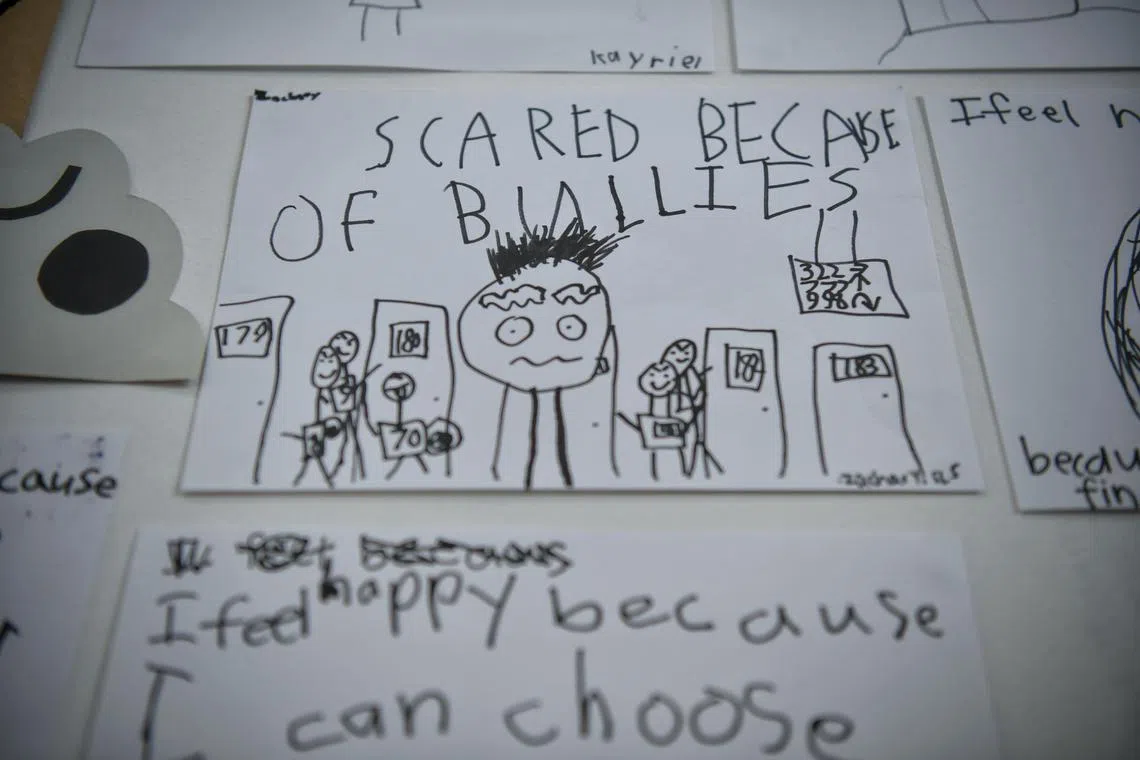News analysis
More transparency, updates needed to reassure parents of bullied students
Sign up now: Get ST's newsletters delivered to your inbox

Several parents that The Straits Times spoke to said more openness in communication would help to bridge the gap of trust.
ST PHOTO: KUA CHEE SIONG
Follow topic:
SINGAPORE – Now and then, a video of bullying and fighting involving children surfaces. A student being punched in class. Another being taunted at a void deck. A group ganging up on a peer.
And when such a clip goes viral, it is usually accompanied by a social media post by a child’s parent or adult relative, pressing for more answers.
The common thread among these incidents is a call for answers and transparency in a timely manner.
And increasingly, social media platforms have become a way for parents to voice their concerns and opinions, even if the number of bullying incidents reported to the Ministry of Education (MOE) has been stable in the past decade.
Details of bullying or fighting cases are not typically disclosed by the MOE because schools investigate the incidents and take disciplinary action while prioritising students’ privacy.
In the past six months, at least four bullying or fighting incidents came to light after being captured on video and circulated online. They involved students from Qihua Primary, Bukit View Secondary, Admiralty Secondary and Montfort Secondary.
In most of these cases, the exact disciplinary actions meted out to those involved were not revealed.
Schools rarely share specifics, leaving parents uncertain about whether “the punishment has fit the crime”, said a father whose daughter was bullied in secondary school. He requested anonymity to protect his daughter’s privacy.
“I want to see that there’s been restorative measures put in place,” he said. “We can’t suspend every child because they bullied another child; it all depends on the severity. But I think the schools need to live by what their policies suggest.”
Second Minister for Education Maliki Osman on March 7
But the ministry may put out facts to ensure a fair account for all parties, including educators, should a case publicised online give an unbalanced view of an incident, he said in response to parliamentary questions.
In the case involving Montfort Secondary
It is one thing for children to fight, but quite another for adults to jump in and take sides, Education Minister Chan Chun Sing has said
To some parents, this approach could make them feel like they are being kept in the dark.
Parents and counsellors acknowledge that privacy is important and not everyone needs to be kept updated on actions taken. Schools have their own disciplinary policies and the prerogative to carry out appropriate actions.
But parents and students who are directly involved – both the bullies and victims – should be apprised of the progress of investigations, including the details of disciplinary actions.
Doing so would more likely help to reassure parents that they are not left out of the loop, while reducing the tendency to react and speculate without having full knowledge.
Ms Adelyn Tan, founder of HiDolphin, an organisation that counsels children and youth, said parents who take to social media to voice their concerns usually resort to it only as a last measure as they feel helpless.
She sees this as a sign of missing trust between parents and schools caused by a lack of communication or information.
Ms Henny Tan, principal psychologist at Us Therapy, said it is difficult for parents to step back emotionally as their instinct is to protect their child from further harm.
“Some parents also feel guilty for not picking up warning signs or stepping in earlier to protect their child,” she said, adding that their anger and frustration might lead to strong reactions directed at the bully and the school.
Building trust
Several parents whom The Straits Times spoke to said more openness in communication would help to bridge the gap of trust.
One mother, who requested anonymity, said that her son was bullied by an older student on the school bus, with the situation escalating to her son being hit and strangled.
The school acted quickly, the 41-year-old marketing manager said, as they identified the bully and contacted his parents within the day, and implemented changes such as seating them separately on the bus.
However, she said, she was not given information about the punishment or any updates on her child in school.
“I feel like the school can take charge of the incident, but at the same time, it really has to update the parents involved about what is going to be done, what has been done, and how the child is doing,” she said.
“Regular updates, even minor ones, can help to reassure parents,” said Us Therapy’s Ms Tan, emphasising the need for clear communication channels between teachers and parents.
These include clearly defined protocols for parents who want to report bullying incidents, so that they know who to contact and what to expect.
Parents too must be reasonable in their expectations and discussions with the school, and find a balance between intervening and giving children space to learn from their experiences, said counsellors.
HiDolphin’s Ms Tan said she focuses on empowering young students to first handle the situation on their own before going straight to the teacher.
This includes teaching them what to say when someone takes their items or keeps bothering them, she said, and this behaviour can be reinforced by parents at home.
Ms Andrea Chan, group head of Touch counselling and psychological services, said that in having open discussions with schools, perhaps parents can assess better if their expectations are practical and reasonable.
Still, it may not be easy for parents to step back and trust schools to handle bullying – especially when their child’s well-being is on the line.
But as Mr Chan has said: “We are our children’s role models – if we act like bullies, online or offline, they will too.
“Threatening, doxing and being disrespectful to other children and teachers are not actions that make our children better. This is also not how we demonstrate to our children that we care for them and protect them.”
Rather than seeking vengeance, the focus for parents should be wanting to see the bully’s behaviour addressed and transformed with compassion, said Touch’s Ms Chan.
Parents can instil in children resilience by teaching them to stand up for themselves and equipping them with coping mechanisms, she added.
This will enable children to better handle difficult situations, such as bullying, with greater confidence and emotional fortitude.


